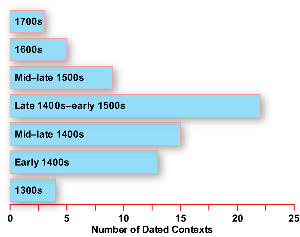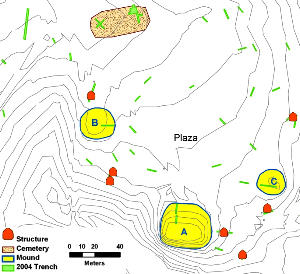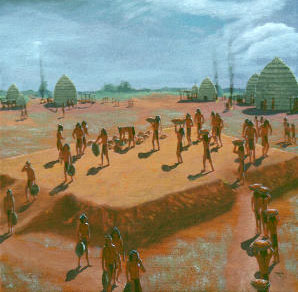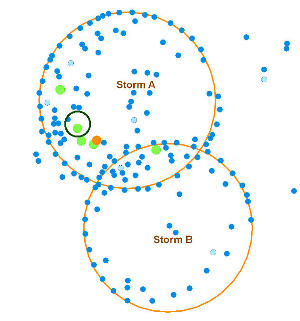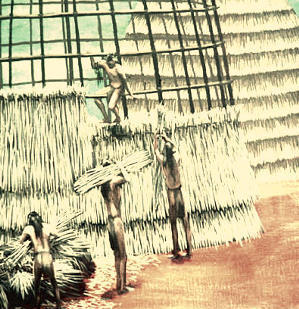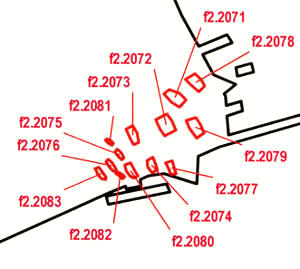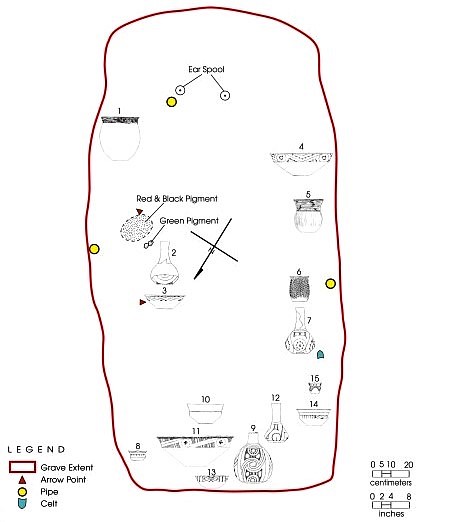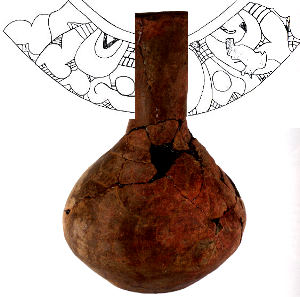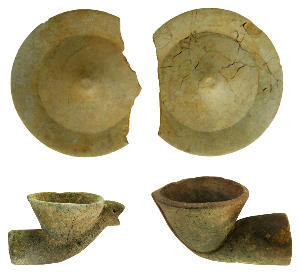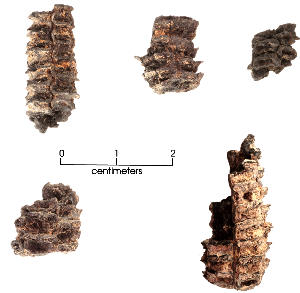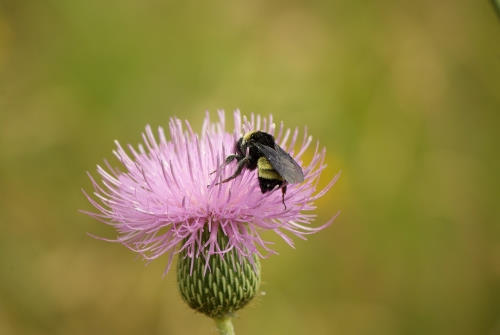Investigations: Uncovering a Caddo Community
Contour map of the Pine Tree Mound site showing the main components and the locations of springs. Inset painting of Caddo village by Nola Davis, Texas Parks and Wildlife Department. |
The investigations conducted at the Pine Tree Mound site were notable in several respects. First, archeologists had the rare opportunity to conduct excavations across the entire complex, including the ceremonial core and the surrounding village areas. To accomplish this, an extensive program of testing, trenching, and excavation was conducted over a period of several years. More than 3000 cultural features, including 3 mounds, perhaps 15 residential compounds, and 38 burials were documented, and thousands of artifacts were recovered. More than 100 radiocarbon samples were analyzed to establish a chronology of the settlement. With this rich body of evidence, the Nadaco Caddo community could be reconstructed and, as a result of the comprehensive evaluation, parts of the site could be set aside and protected from future disturbance. The Ceremonial PrecinctThe place to start talking about the archeology of the Pine Tree Mound community is the area that was the focus of ceremonial activities. This ceremonial precinct, which was the center of the higher-level religious and political activities for the entire community, encompasses some 14 acres. At its heart, and covering about half of it, was the plaza, which apparently did not contain any substantial buildings. According to Timothy Pauketat, an expert on the archeology of Mississippian peoples who lived in the American Midwest and Southeast at the same time the Caddo were in northeast Texas, Louisiana, Arkansas, and Oklahoma, these central plazas—not the surrounding earthen pyramids—“were the anchoring features of these central built landscapes,” with “plazas…often designed, engineered, and built at the very inception of a Mississippian town.” This probably was true at Pine Tree Mound as well. The plaza at Pine Tree was bounded on the south, east, and west by three mounds, and on the north by a slope leading down to a spring-fed drainage (later dammed to make a stock pond). At its northwest corner was one or more burial plots, or perhaps more likely a large cemetery, that probably was marked by aboveground poles. The Caddo who lived at Pine Tree may have buried hundreds of people here, including the highest-status members of the community. Radiocarbon dates indicate that use of this cemetery began early in the history of the ceremonial precinct, if not at the beginning. Over time in the 1400s and 1500s, the Caddo built ceremonial buildings and probably houses for people who were responsible for the up-keep of these buildings and the ceremonies conducted there between and around the mounds. From the archeological work, we know there were at least seven such buildings. The MoundsThe most conspicuous features visible at the Pine Tree Mound site today, and when the Caddo lived there, are the earthen mounds, the tallest of which stands nearly 8 ft (2.4 m) high. But the appearance of the site in modern times was dramatically different than in its prehistoric heyday. The open, grassy pastures were used for cattle ranching rather than gardening and village activities. A ranch house had been built on top of the largest mound in the 1960s, and a cattle feeder on one of the smaller mounds. Two barns, livestock pens, and a second house also had been built in various parts of the site. These modern buildings, since removed, were still standing during investigations, and archeologists conducted their work in the midst of them, with trenches running up to the edge of the ranch house. The largest mound, Mound A, was at the southern edge of the open area interpreted as the plaza. It was 180 ft (55 m) long and 145 ft (45 m) wide and originally was about 10 ft (3 m) high. Archeologists placed a large trench through Mound A and found it had only a few layers above the natural ground surface and no evidence for buildings within it. Apparently, it was constructed rapidly as a platform, probably to support one or more important buildings such as temples, on its summit. The Caddo also may have had ceremonial buildings on the spot before the mound was built. Mound C on the southeast edge of the plaza was similar to Mound A in that it went up quickly and had a ceremonial building on its crest, as well as one or more in that location before the mound was there. Mound C was much smaller, though, just 90 ft (27 m) long, 108 ft (33 m) wide, and less than 3.5 ft (1 m) high. Mound B was on the west side of the plaza. At 120 ft (37 m) long, 108 ft (33 m) wide, and 4 ft (1.2 m) high, it was a little larger than Mound C, but it was different than the other two mounds in that it was created through the construction, destruction, and capping of a sequence of important buildings in this spot. Unlike at the other mounds, the builders’ goal was not to create a platform on which buildings would sit. Instead, they erected a building in a shallow depression dug into the ground, later destroyed that building and covered it over with earth, and repeated that process several times. Eventually, Mound B grew to the size it was when archeologists dug into it in 2004, or actually a little larger, since erosion had removed part of its top by then.
|
|
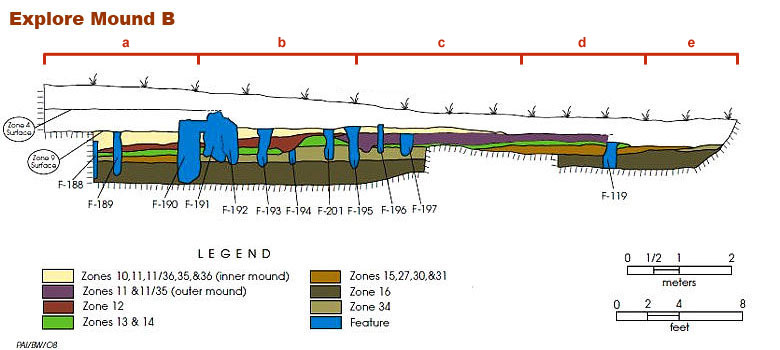
This drawing shows the layers of dirt, called zones, in one wall of a long trench archeologists dug into Mound B, revealing how the mound accumulated. Mound B not only had more layers than the other two mounds, but also clear indications that buildings had been erected on its exposed top as it grew. The areas labeled as “features” in the drawing, most of which are postholes cut in half by the trench wall, are what prove that buildings were there. View detailed photos and descriptions of the layers and features by mousing over and clicking on each of the five lettered segments of the image. |
The layout of some components of the ceremonial precinct likely was guided by the cosmology of the people who worshipped here. Based on analysis of the burials, archeologists concluded that the positions of the sunrise and the stars Antares and Sirius were important to these people. The fact that, when viewed from Mound A, the sun rises over Mound C at the summer solstice in June indicates this, and the positions of Mound B and the cemetery relative to Mound A mirror the northwest-southeast orientation of the burials, which is perpendicular to the summer solstice sunrise. Household CompoundsDuring testing, archeologists identified eight areas at Pine Tree Mound that could have contained houses for the residents of the community. They excavated three of these and decided that at least 15 household compounds—houses and work areas—once surrounded the east, west, and south sides of the ceremonial precinct. The excavations discovered posthole patterns that marked wall posts for 38 circular structures or houses, averaging about 20.5 ft (6.3 m) in diameter. Constructed of a circular framework of poles tied together at the top and covered over with bundles of grass thatch, the houses would have resembled large beehives. Evidence recovered from within the interior of the houses suggested areas where doorways may have been located, where smokey fires may have burned, and where sleeping benches and storage areas may have lined the walls. Within the residential compounds, archeologists also found a few rectangular patterns that may have been shelters for outdoor work areas or elevated work platforms. In addition, they uncovered many pit features resulting from outdoor activities in and around the structures, along with much debris—such as broken stone tools, flakes of stone left over from making tools, sherds from broken ceramic pots, animal bones, burned corn cobs and pine cones, and wood charcoal—from the daily lives of the people who lived there. Within each area, or compound, it appears that only one or two houses were standing at any one time. Each of these probably was home to a single family or two related families, with six to ten people living there over spans of 100–200 years. Some houses were built, occupied for a time, and then abandoned, while others were substantially rebuilt up to three times before abandonment. Deterioration of construction materials, especially wall posts, likely dictated when a house was rebuilt. This could explain some of the variation in house size, for example, reuse of shorter recycled posts necessitating smaller houses. Other factors such as changes in family size or status could have been at play as well, but clearly the propensity to rebuild on or near the same spot suggests the Caddo who occupied these places had a connection to the land that persisted over many years. That is why the archeologists interpreted them as multigenerational family compounds. |
|
Offerings in the GravesSpecial offerings were placed in the graves of many of the Caddo buried at Pine Tree Mound. The 23 grave offerings found with the individual in the grave shown at right are representative of those found in the other graves and provide a glimpse of Caddoan burial rituals. They consisted of 2 stone ear spools, 3 ceramic smoking pipes, 1 stone celt, 2 arrow points, and 15 ceramic vessels. One of the pipes was found near the ear spools and would have been to the right of the cranium. The stem of this pipe wraps up around the bowl and is in the shape of a serpent’s head. This pipe is the only animal effigy discovered at the site. The numbers and kinds of offerings indicate this individual was of high status and well connected in the Pine Tree Mound community. |
|
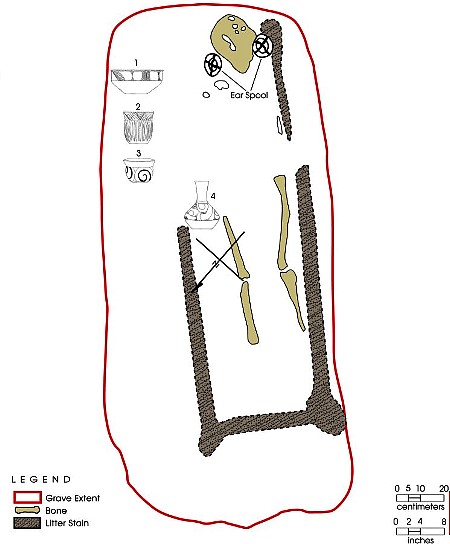
|
One grave, Feature 8.1088, contained the remains of an individual, probably a woman, who had been placed on a litter made of wooden poles and probably covered with a mat of woven reeds. Her family buried her with a pair of stone ear spools, carved with circle-and-cross motif, and four pottery vessels. One of these, a bottle of undetermined type, carved with a unique motif, lay in the area of the right hand of the deceased. |
Most of the offerings the archeologists found were of hard materials that could not decay away, but they did find traces of some of the many perishable offerings that must have been placed there. For example, there were some stains in the soil that were left when woven reed mats placed in the bottoms of graves disintegrated. These mats probably had been stained bright colors and may have been adorned with bird feathers. One or two graves even had soil stains showing that the deceased had been buried lying on litters of wooden poles lashed together. The graves contained 145 ceramic vessels of varied styles and shapes. These were analyzed to determine how the Caddo used them, for example, whether some were cooking pots or serving bowls, storage containers for foodstuffs or drink, or used in particular rituals. The analyst also studied the construction of the vessels to determine how the potters made them, what kinds of materials they added to the clay to make pots stronger, and how they finished the interiors and exteriors to make them more or less porous. This information, as well as shapes and sizes of the vessels, helped determine function. Decorations on the vessels, particularly those of the style known as Ripley Engraved, also were studied. It is believed the decorations were applied not just for esthetic reasons but also for symbolic purposes, conveying information about how the potters saw the world and their place in it. (See Ceramic Vessels and Iconography section for more detail.) What sets the Ripley style apart from the other pottery types found (most of which are in styles called Pease Brushed-Incised, Wilder Engraved, Harleton Applique, and Maydelle Incised) is how the potters configured the various parts of the engraved designs, which included scrolls, diamonds, circles, and crosses in circles, to name a few. |
|
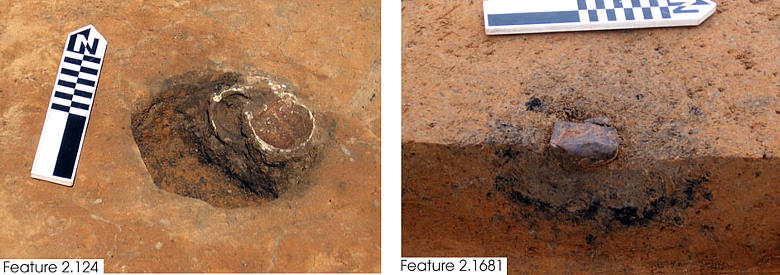
|
Gardens, Fields, and FoodThe Caddo word “Nadaakuh,” from which Nadaco is derived, means “the place of the bumblebee” or the people of that place, and this conjures up an image of a large open area with lots of flowering plants. Bumblebees would have been great pollinators of squash and other plants favored by Caddo gardeners. From the archeological evidence, we know they grew maize, beans, squash, and gourds. Evidence of these plants survived in pit features and smudge pits because they happened to be burned. Smudge pots are small shallow pits with lots of charcoal. They probably held smoky fires used to control insects, prepare animal hides, or cook meals. They were found both inside and outside houses. The excavations also recovered maygrass, Chenopodium, little barley, and erect knotweed seeds as well, indicating use of wild starchy-seeded annual plants. Other plant remains found representing foods, or in some cases perhaps medicines, are sumac fruits, waterlily or pondlily buds, American lotus seeds, Virginia creeper or grape fruits, persimmon seeds, blackberry seeds, verbena nutlets, and bulbs that could be from plants such as wild garlic or camas. The sumac remains may be present because this plant commonly is a colonizer of old agricultural fields. The fields situated on the fertile lands around and between the house compounds would have provided ample foodstuffs for the community year-round, augmented by fish from the nearby creeks and game, especially white-tail deer, hunted in areas away from the site. One feature of the landscape that was important to both the Caddo and the people who ranched there until recently were natural springs, since they provided abundant fresh water. There were at least seven springs on the site, two of which contributed to the formation of drainages that were natural boundaries for the ceremonial area and that, in modern times, were dammed to create a stock pond and a small lake. Pine Tree and BeyondAlthough Pine Tree Mound was just one community within the larger Caddo world, excavations indicate it was a very important site. This is where the community leaders and the elite members lived and conducted the ceremonies and rituals that bound the community together. By drawing on information from other investigated Caddo sites, we are able to extend our view and address not only topics dealing with mundane aspects of their daily lives—for example, how they built their houses and what kinds of crops they grew—but also questions relating to the configuration of the community as a whole. As a result, the archeology of the Pine Tree Mound site provides new perspectives on the nature of the Nadaco community’s religious and cosmological beliefs and how those beliefs may have connected them, socially and politically, to their neighbors. These topics are explored further in the following sections. |
|

